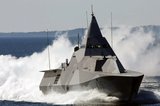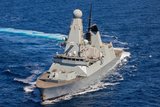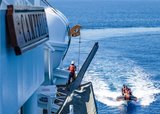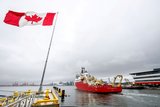TKMS introduces new submarine fuel cell
Thyssenkrupp Marine Systems (TKMS) has unveiled its 4th Generation Fuel Cell (FC4G) for utilisation in submarines, following completion of a comprehensive test programme for the propulsion system.
FC4G has undergone in excess of 70,000 operating hours of testing, demonstrating the hydrogen-fuelled system’s performance.
‘Our customers have been using our fuel cell systems for more than 15 years now,’ Rolf Wirtz, CEO of Thyssenkrupp Marine Systems, said.
‘With this fourth generation we are making something great even greater. This is the next big step with huge improvements in availability, redundancy, and stealth.’
The fuel cell is designed to be a high-availability modular system composed of redundant components to retain a maximum performance at all times, according to the company.
The system relies on the proven and safe hydrogen storage method of using metal hydride cylinders as was the case with previous generations, which do not contain any active components, so are less inclined to fail, holding the hydrogen molecules in place in the crystal lattice of the hydride.
Furthermore, since hydrogen is fed to the system in its purest form, no chemical conversion is required, so the efficiency of the overall system remains high.
The only by-product besides electrical energy is pure water, which is stored on board for weight compensation.
H2 is a gas that is available in most countries that the company would be looking to cell the fuel cell, and can be produced by utilising green energy sources by splitting water into H2 and O2.
With no by-products put overboard, the thermal and acoustic signatures produced are kept to a minimum, while TKMS says that the overall system efficiency is twice as good as a combustion engine.
‘These are the reasons why 38 systems were contracted so far with seven customer navies, another ten systems presently being under negotiation,’ Philipp Schön, head of product sales for submarines, added.
More from Naval Warfare
-
![Sweden’s decision on four new warships inches closer as it eyes UK, France and Spain]()
Sweden’s decision on four new warships inches closer as it eyes UK, France and Spain
Sweden decided last year that it wanted a significantly larger warship for its Luleå Class programme than originally planned, with three likely contenders that could potentially deliver within the country’s tight schedule.
-
![US Coast Guard prepares procurement of next-gen surface search radar]()
US Coast Guard prepares procurement of next-gen surface search radar
The NXSSR will replace five in-service capabilities and be the US Coast Guard’s primary collision avoidance system.
-
![MBDA-led DragonFire’s latest trials move the LDEW system closer to UK Navy integration]()
MBDA-led DragonFire’s latest trials move the LDEW system closer to UK Navy integration
The DragonFire lines up with other European laser-directed energy weapons being developed in collaboration with MBDA.
-
![US Coast Guard pursues solutions to increase maritime domain dominance]()
US Coast Guard pursues solutions to increase maritime domain dominance
The USCG is seeking technologies, services and applications to better connect its assets and speed up the decision-making process.
-
![Canadian Coast Guard’s OOSV delivery is “major milestone” in fleet modernisation]()
Canadian Coast Guard’s OOSV delivery is “major milestone” in fleet modernisation
The Polar Class 6 platform is the largest CCG science-dedicated vessel and will operate on the country’s east coast.






















